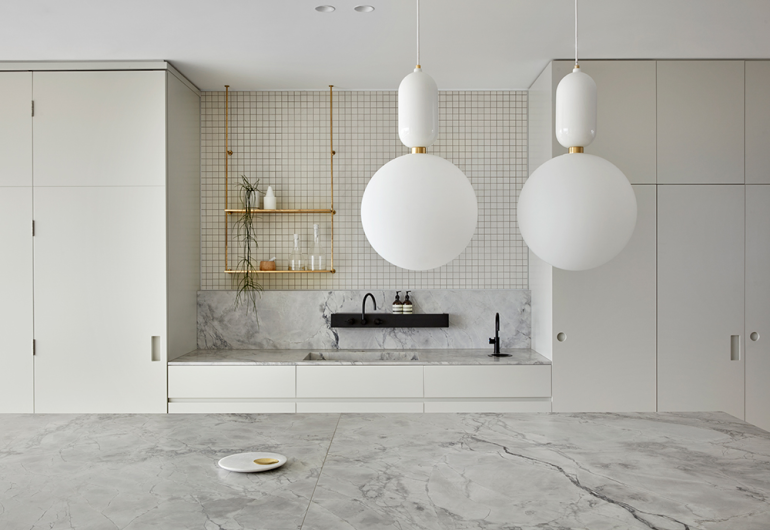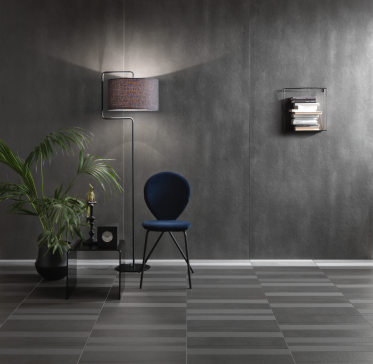
The Sugie Series tiles featured in the Memocorp kitchen by The Stella Collective
The history of Japanese ceramics stems back many centuries. In the last 100 years – through collaborations with designers, architects and makers – those traditions have found new applications for more than just vases and tableware .
This new generation of Japanese innovation began in 1918 with the construction of Tokyo’s Imperial Hotel, designed by American architect Frank Lloyd Wright, who commissioned Hatsunojo and Chozaburo Ina to produce over four million individual tiles and bricks in three short years. A collaboration of craft and composition that explored new colours, techniques and survived several seismic shifts.
This collaboration formed the foundations of the company now known as INAX. Creators of the first shower toilet, automatic tap system and numerous award-winning bathroom innovations, not to mention the continued development of their heritage – ceramic tiles.
It is fair to say INAX understands design, efficiency, water and hygiene like few other manufacturers – they are, after all, Japanese and so they also understand technology. A complex mix of craft and circuitry underpin their range of taps and toilets but when it comes to tiles it is more focussed on developments in their craft and their tradition of working alongside international creatives.

The INAX 2x1 tiles add a Japanese aesthetic to this kitchen by Tom Robertson Architects.
In Australia, that means tiles that are tailored to our needs and desires – be it new colourways, finishes or glazes that are easier to maintain, indoors and out.
Like the collaboration with Frank Lloyd Wright, these innovations come through a strong working relationship and respect of culture. Something Artedomus have built, becoming a conduit between Australian architects and the product development team at INAX, with the result speaking for themselves through their increasing popularity locally.
While the potential to customise tiles exists, it is traditionally only possible for projects of a larger, more commercial nature given the expense and complexity. Although through Artedomus's relationship with INAX, new products and finishes are constantly being explored for our local market. As an example, a recent project in Western Australia led to the development of a specific green glaze for a one-off project which is now added to the Sugie Series range nationally.

Selecting tiles that require a minimal amount of care is essential, indoors, or out.
Even without customisation, the Sugie Series represents substantial innovation being highly durable with non-stick properties, rare for a tile that is 50mm square. In addition, it uses a matt glaze finish which requires little maintenance, making it perfect for both floors and walls.
Known as a Hanten matt glaze, it visually softens even the hardest of ceramics and is also used on INAX’s 2x1 inch mosaic.
Softening the edges even further, the MDK 34 glaze in matt dark grey is a burnished glaze designed to diffuse light and deliver a quiet sheen. Initially developed for the Madoka range of square tiles, Artedomus in collaboration with INAX have extended its use to additional collections specific to the Australian market.
Extending on these progressions, and the Japanese aesthetic, the new Reitz Nicho tile responds to our growing desire for matt terracotta tiles. Utilising a Nano glaze, a protective barrier is created – eliminating the ability of dust, dirt and oil to penetrate the surface making them essentially self-cleaning and stain resistant. Perfect for wet areas, pools, floors and external finishes.
While these innovations are based on traditions of craft and chemistry that are hundreds of years old, they remain relevant to our homes and way of life, creating spaces that are not just beautiful but efficient, sustainable and hygienic.
INAX tiles are exclusive in Australia to Artedomus.
_
HOUSELAB HINTS
KEY CONSIDERATIONS
For any kitchen, bathroom or wet area (including around the pool) the major factors in choosing the right tile are:
- Durability, and tiles that provide grip to avoiding slipping
- Ease of maintenance, certain finishes have non-stick properties making them easier to clean
- Aesthetics and tile size
INSTALLATION
- Like any other element of the home, using an experienced tradesman or tiler is essential
- Paperfaced tiles are easier to apply and provide consistency when grouting
- Cladding tiles are groutless and use special adhesives, this means wall structures need to be designed to carry the weight
APPLICATIONS
- Popular in Japan, and utilised on the the Sydney Opera House, tiles can be an ideal alternative to rendering exterior walls
- Consider tiles as an alternative to a painted feature wall or as the facade of an island bench
WRITTEN BY HouseLab










